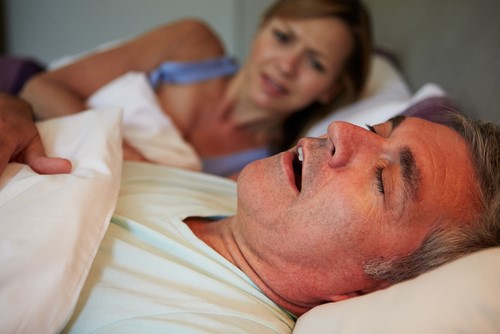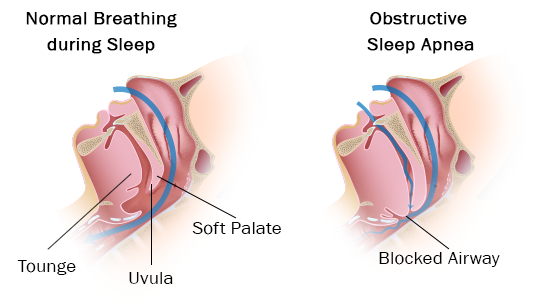
SLEEP APNEA
SLEEP APNEA is a common disorder in which you have one or more pauses in breathing or shallow breaths while you sleep.
Breathing pauses can last from a few seconds to minutes. They may occur 30 times or more an hour. Typically, normal breathing then starts again, sometimes with a loud snort or choking sound.
Sleep apnea usually is a chronic (ongoing) condition that disrupts your sleep. When your breathing pauses or becomes shallow, you’ll often move out of deep sleep and into light sleep.
As a result, the quality of your sleep is poor, which makes you tired during the day. Sleep apnea is a leading cause of excessive daytime sleepiness.
Overview
Sleep apnea often goes undiagnosed. Doctors usually can’t detect the condition during routine office visits. Also, no blood test can help diagnose the condition.Most people who have sleep apnea don’t know they have it because it only occurs during sleep. A family member or bed partner might be the first to notice signs of sleep apnea.
The most common type of sleep apnea is obstructive sleep apnea. In this condition, the airway collapses or becomes blocked during sleep. This causes shallow breathing or breathing pauses.
When you try to breathe, any air that squeezes past the blockage can cause loud snoring. Obstructive sleep apnea is more common in people who are overweight, but it can affect anyone. For example, small children who have enlarged tonsil tissues in their throats may have obstructive sleep apnea.
Common symptoms of sleep apnea include:
- Loud or frequent snoring
- Silent pauses in breathing
- Choking or gasping sounds
- Daytime sleepiness or fatigue
- Unrefreshing sleep
- Insomnia
- Morning headaches
- Nocturia (waking during the night to go to the bathroom)
- Difficulty concentrating
- Memory loss
- Decreased sexual desire
- Irritability
There are three types of sleep apnea:
- Obstructive sleep apnea (OSA): The more common of the two forms of apnea, it is caused by a blockage of the airway, usually when the soft tissue in the back of the throat collapses during sleep.
- Central sleep apnea: Unlike OSA, the airway is not blocked, but the brain fails to signal the muscles to breathe, due to instability in the respiratory control center.
- Complex sleep apnea syndrome, also known as treatment-emergent central sleep apnea, occurs when someone has both obstructive sleep apnea and central sleep apnea.
Muscle weakness within the tongue, mouth, and upper throat may lead snoring and obstructive sleep apnea. This may be improved with myofunctional therapy.
Myofunctional Therapy And Sleep Apnea
The oropharynx is the part of the body that includes the mouth and throat. In simple terms, it is a tube lined by muscular tissues. These muscles help us to eat, talk, and breathe. They also help to keep the airway open, especially during sleep. When the muscles of the oropharynx are weak, they may disrupt the flow of air and snoring may ensue. If they let the tube collapse, the airway becomes blocked, such as happens during sleep apnea. Moreover, a weak and floppy tongue may fall back into the throat and create an obstruction. Myofunctional therapy includes exercises that are meant to improve the strength of the muscles within the oropharynx, including the tongue. In addition, it helps to reinforce the proper position of the tongue within the mouth

Diagnosing Sleep Apnea
If you suspect that you have sleep apnea, the usual first step is to discuss your suspicions with your primary care physician. If you don’t have a primary care physician, you can go directly to a clinician who is a sleep specialist. But check your health care insurance coverage first. Some policies require you to see a primary care physician first, and some policies limit the sleep centers and testing facilities whose services they will pay for.
Sleep specialists come from a variety of medical backgrounds. They may be pulmonologists (lung specialists), otolaryngologists (ears, nose, and throat), neurologists (brain and nerves), psychiatrists (mental health), or primary care physicians–internists and family practitioners. Some dentists also have special training in the treatment of sleep disordered breathing, which includes sleep apnea. You can check the credentials of specialists at the web sites of the American Board of Internal Medicine and the American Board of Sleep Medicine.
Testimonials
My son, Ryan, is a 16 year old who suffers from Autism as well as a syndrome that causes some dysmorphic facial features. Due to structural anomalies Ryan has a hard time closing his mouth, is a mouth breather, drools , has trouble forming certain sounds and his tongue pressing against his teeth is causing his teeth to push outward despite braces. Ann started doing myofacial therapy with Ryan and I cannot believe the change. It is so different from what his Speech therapist is doing. He is better able to control his mouth, his mouth is not hanging open as much and the drooling has decreased drastically. She is very patient with him because he has a hard time with body awareness, which causes us to have to do everything over and over, but I cannot believe the change in him. She is dedicated to helping in ways I didn’t even know possible. No one tells us these services are available. Now that I see what she is able to accomplish, all I can see is the amount of children that would benefit from her services. Not only is she a therapist, but a teacher as well. She patiently explains everything to me so that I can continue to work with Ryan at home. I am excited to see all the improvements that are yet to come.
I first started in orthodontic treatment at twelve years old, and now at twenty years old I have completed two full length rounds of standard braces, and one major double jaw surgery. All of these treatments have failed to one degree or another due to my persistent tongue thrust as soon as my treatment was complete. I then began a final course of Invisalign, and decided to give Myofunctional therapy a try in conjunction so that I had a chance at no relapsing after my correction. In less than three months I had a ninety percent fix of my tongue thrust, and my only regret is that I didn’t start when I was twelve. Ann worked with me on my schedule (extremely busy as an undergraduate student), and even over FaceTime to save me long trips to an office. With a little persistence and discipline in keeping up with exercises, I’ve been able to correct a problem that has cost thousands of dollars in orthodontia and years of my life in braces. I recommend myofunctional therapy to anyone who is experiencing problems with their corrective treatment. It was an absolute game changer for me, and I recommend jumping on with treatment as soon as possible!
Because of the exercises you nave shown me and because of your help. I am no longer choking on my tongue at night. My tongue stays at the top ot my mouth so that I am not mouth breathing, which means I am sleeping so much better.. You are so knowledgeable , and have been immensely helpful and I truly appreciate you! –
Doing Myofunctional Therapy has been a game changer, especially for someone who never realized a tongue thrust was a real thing I had to worry about. I have always questioned why my top front teeth were becoming buck and ended up going through 2 rounds of braces before we caught onto the real problem that I had a tongue thrust. Working with you was great! We took time to improve the problem doing various exercises and really dug deep into the situation. Exercises were effective and got the job done in a non-frustrating way. You were very flexible, especially for someone like myself who has a busy schedule. The platform we used to do sessions online was great, so you can do everything from the comfort of your home. Lots of times, people find it hard to drive to an appointment. I would give you a 10 out of 10 rating for these reasons. Thank you for all your help!
My experience with Myofunctional Therapy as amazing. Ann always went out of her way to make appointments work to fit my schedule. The results truly changed my smile with strengthening exercises and practice. My future and smile both seem brighter because of what Myofunctional Therapy has done to me.
Thanks a ton!
I feel like it really helped me. It really helped me remember to put my tongue to spot and I improved my /r/ sound.
